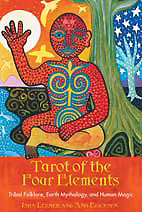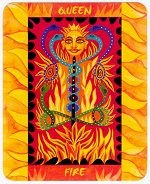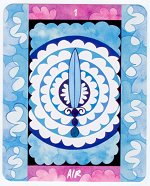|
Tarot Reflections |
April 15, 2005 |
| Review: Tarot of the Four Elements Sandra Thomson, CTGM |
|||||||
|
Lerner's chapter on "The Magic of Numbers, Form and Color," is quite extensive historically, especially with regard to numerology, and some of her writing here may be quite enlightening to those who have not through very much about numerology and the Tarot. Lerner succinctly summarizes a number of ideas from the Pythagorean and others schools of thought. She does not elaborate so extensively on how colors resonate except to associate them with the seven chakras.
For those who care about such things, the backs have four columns symbolically indicating the four elements and printed in such a way that you cannot tell whether a card is reversed or not. The borders of each of the four Minor Arcana suits match one of those designs (orange/tongues of fire/wands, green/earth/plants, blue/air/clouds, greenish/water/swirling waves and sea currents). Each Minor Arcana card has its element printed at the bottom of the card and its number or court card name at the top. As for the Majors, well, their borders are a razzle-dazzle of color, with the name at the bottom and the numbers also printed at the top. The cards are slightly oversize (3 1/2" by 4 1/2") and for me this makes them better meditation cards than ones to be used for reading, but I have small hands. Some of the Major Arcana cards have been renamed from the traditional RWS titles. The Hierophant (5) becomes the Priest, which is the way many people already think of this card. The Hanged Man (12) is renamed Shaman. Judgment (20) becomes Realization, and The World (21) is Universe.
Many of the definitions of the Major cards are not that unique (although some are), but all are poetically written in a style that may open your heart to new ideas and perceptions that you may also want to apply to other decks. Writing about the Minor Arcana cards, Lerner briefly describes the cards (most have designs rather than figures except court cards) as it relates to its number. She concludes with a paragraph on what it means when the card turns up in a reading. It is in the Minor Arcanas that Lerner's writing becomes the most unique and provocative for me. For instance, the Queen of Fire (Queen of Wands) suggests you become more alive in the moment. "What's going on right now in your life that's electrifying, exciting, stimulating, and energizing," she writes. "You are a lightning rod for dynamic change and empowerment as a soul-infused personality." Did you get that understanding of the Queen of Wands from your RWS card? If you did, you're way beyond me and need to be writing the next RWS text for slow-witted Tarotists like me.
Finally, as I frequent do, I ask this deck what final thing it wanted me to know about it. I drew the Ace of Air, the "root and source of mental inspiration." The card shows a sword positioned upright at the center of a "wheel" of concentric circles. Its purpose is to pull "you into a vortex of psychic energy and suggests the need to be more strong-willed and single-minded in your goals," says Lerner. Zero in on a single activity and do it with complete devotion, zeal, and confidence. In other words, Sandra, I'm the deck, for you for a while and don't you dare think otherwise. As if to come full-circle, Lerner writes that one can utilize the image as a centering device for meditation. Okay, okay, I get it. I am your obedient, meditational servant. P.S. Don't anyone tell this deck that I have other decks. Not yet, anyway. Tarot of the Four Elements (ISBN# 159143030-5) is published by Bear and Company, a division of Inner Traditions International, Rochester, Vermont. |
||||||
|
|
|||||||
|
Subscribe to Tarot Reflections, and receive notification of each update! |
|
Request to be added to the list by sending email to TarotReflections-subscribe@yahoogroups.com! |
All articles remain the
property of their respective authors.
Tarot Reflections is a publication of the American Tarot Association
- Copyright (C) 2005
Questions or Comments? Contact Us.



 The book has four layout patterns ranging from one to four cards: The Essential Self (one card), Balancing the Soul (two cards), Manifesting Dreams and Visions (three cards), and The Four Directions (four cards plus an optional fifth). The spreads are not particularly unique (despite its lovely name, the three-card positions are body, mind, spirit) except in the ways in which you select the cards from the deck.
The book has four layout patterns ranging from one to four cards: The Essential Self (one card), Balancing the Soul (two cards), Manifesting Dreams and Visions (three cards), and The Four Directions (four cards plus an optional fifth). The spreads are not particularly unique (despite its lovely name, the three-card positions are body, mind, spirit) except in the ways in which you select the cards from the deck. When Lerner writes about each Major Arcana card, she presents ideas about (1) the traditional image and its meaning, (2) the Tarot of the Four Elements meaning, and (3) the Elemental Message of the card, plus a few final key words. For instance, the beautiful—well, they're all beautiful—Realization card does not represent Gabriel's clear call as much as it represents a being rising up from a portal of time and space, greeting a new dimension of reality, unleashing "waves and spirals of magical potentials." The elemental message is to "rise up and release" all that may have been holding you back and to "celebrate this triumphant miracle."
When Lerner writes about each Major Arcana card, she presents ideas about (1) the traditional image and its meaning, (2) the Tarot of the Four Elements meaning, and (3) the Elemental Message of the card, plus a few final key words. For instance, the beautiful—well, they're all beautiful—Realization card does not represent Gabriel's clear call as much as it represents a being rising up from a portal of time and space, greeting a new dimension of reality, unleashing "waves and spirals of magical potentials." The elemental message is to "rise up and release" all that may have been holding you back and to "celebrate this triumphant miracle." The Five of Earth (Pentacles) suggests it may be time to "continue your efforts to strike out in a new direction." The "huffy puffy" King of Air (Swords) is a delightful figure who seems to have evolved from "swirls, spirals and waves of energy" and tells you to "live up to your higher calling in life." As Sister Wendy would say, I am besotted by all the bewitching, energetic court cards in this deck.
The Five of Earth (Pentacles) suggests it may be time to "continue your efforts to strike out in a new direction." The "huffy puffy" King of Air (Swords) is a delightful figure who seems to have evolved from "swirls, spirals and waves of energy" and tells you to "live up to your higher calling in life." As Sister Wendy would say, I am besotted by all the bewitching, energetic court cards in this deck.